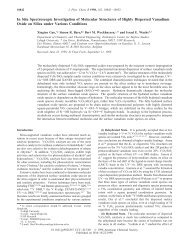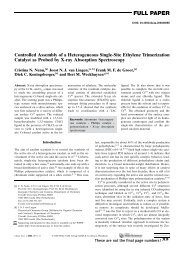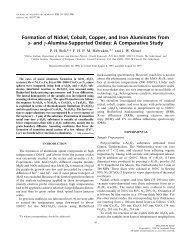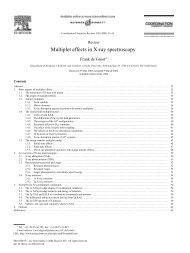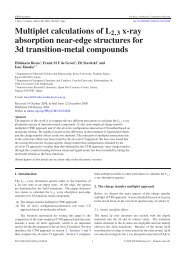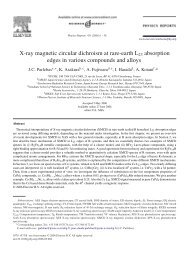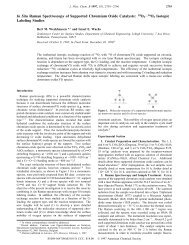In Situ Raman Spectroscopy of Supported Chromium Oxide ...
In Situ Raman Spectroscopy of Supported Chromium Oxide ...
In Situ Raman Spectroscopy of Supported Chromium Oxide ...
- No tags were found...
Create successful ePaper yourself
Turn your PDF publications into a flip-book with our unique Google optimized e-Paper software.
J. Phys. Chem. 1996, 100, 14437-1444214437<strong>In</strong> <strong>Situ</strong> <strong>Raman</strong> <strong>Spectroscopy</strong> <strong>of</strong> <strong>Supported</strong> <strong>Chromium</strong> <strong>Oxide</strong> Catalysts: Reactivity Studieswith Methanol and ButaneBert M. Weckhuysen* ,† and Israel E. WachsZettlemoyer Center for Surface Studies, Department <strong>of</strong> Chemical Engineering, Lehigh UniVersity,7 Asa DriVe, Bethlehem, PennsylVania 18015ReceiVed: February 22, 1996 XThe interactions <strong>of</strong> methanol and butane with supported chromium oxide catalysts under oxidizing and reducingconditions were studied by in situ <strong>Raman</strong> spectroscopy as a function <strong>of</strong> the specific oxide support (Al 2 O 3 ,ZrO 2 , TiO 2 , SiO 2 , Nb 2 O 5 , 3% SiO 2 /TiO 2 , 3% TiO 2 /SiO 2 , and a physical mixture <strong>of</strong> SiO 2 and TiO 2 ) andchromium oxide loading (1-6 wt% CrO 3 ). Two surface chromium oxide species were observed on the TiO 2 ,ZrO 2 , Al 2 O 3 , 3% SiO 2 /TiO 2 , and a physical mixture <strong>of</strong> SiO 2 and TiO 2 surfaces: a monomeric species(characterized by a CrdO stretching frequency at ∼1030 cm -1 ) and a polymeric species (possessing a CrdOstretching frequency at ∼1005-1010 cm -1 and a Cr-O-Cr bending mode at ∼880 cm -1 ). The SiO 2 and3% TiO 2 /SiO 2 surfaces possess only the monomeric species. The extent <strong>of</strong> reduction <strong>of</strong> the surface chromiumoxide species, reflected by the decrease in the <strong>Raman</strong> intensity <strong>of</strong> the CrdO bonds, demonstrates that thepolymeric surface chromium oxide species is more easily reducible than the monomeric chromium oxidespecies on the same support. The extent <strong>of</strong> reduction <strong>of</strong> the surface chromium oxide species strongly dependson the specific oxide support (3% TiO 2 /SiO 2 ≈ 3% SiO 2 /TiO 2 ≈ (SiO 2 + TiO 2 ) ≈ TiO 2 > ZrO 2 ).<strong>In</strong>troduction<strong>Supported</strong> chromium oxide catalysts are crucial in thechemical industry for the production <strong>of</strong> several importantcommodity chemicals. 1-9 Cr/SiO 2 catalysts are known as thePhillips catalyst for the production <strong>of</strong> high-density polyethylene(HDPE) and linear low density polyethylene (LLDPE), andCr/Al 2 O 3 catalysts are used for the dehydrogenation <strong>of</strong> butaneto butene. The industrial importance <strong>of</strong> chromium oxidecatalysts has attracted a great deal <strong>of</strong> interest in industrial andacademic research toward the elucidation <strong>of</strong> the molecularstructure <strong>of</strong> supported chromium oxides. This subject hasbeen recently reviewed by us and there is now a generalconsensus that different oxidation and coordination states <strong>of</strong> Cr(Cr n+ with n ) 2, 3, 5, and 6) can be present, which depend onthe pretreatment, the Cr loading, and the support type andcomposition. 10<strong>Raman</strong> spectroscopy (RS) is an excellent technique forstudying supported metal oxide catalysts because this techniquecan discriminate between the different molecular states <strong>of</strong>supported metal oxide species since each state possess a uniquevibrational spectrum that is related to its structure. 10 <strong>In</strong> previousRS studies, chromium oxide catalysts were studied underhydrated and dehydrated conditions as a function <strong>of</strong> the supporttype and composition. 11-21 These characterization studiesrevealed that under hydrated conditions the molecular structure<strong>of</strong> the surface chromium oxide species is only determined bythe isoelectric point (IEP) or net pH at point <strong>of</strong> zero charge(PZC) <strong>of</strong> the support. 20 The chromate:polychromate ratioincreases with the IEP <strong>of</strong> the support and with decreasing Croxide loading. Upon calcination, dehydrated surface chromiumoxide molecular structures are formed by reaction with thesurface hydroxyl groups <strong>of</strong> the support. 22-24 These dehydratedsurface chromium oxide species are highly distorted and possessdifferent structures than found in the hydrated states.* To whom correspondence should be addressed.† Present address: Centrum voor Oppervlaktechemie en Katalyse, K.U.Leuven, Kardinaal Mercierlaan 92, 3001 Heverlee, BelgiumXAbstract published in AdVance ACS Abstracts, August 1, 1996.S0022-3654(96)00543-6 CCC: $12.00However, all previous characterization studies were conductedunder hydrated or dehydrated conditions and, to our knowledge,no in situ <strong>Raman</strong> spectroscopy studies <strong>of</strong> supported chromiumoxide catalysts under catalytic reaction conditions have appearedin the literature to date. <strong>In</strong> general, in situ <strong>Raman</strong> data underreaction conditions are presently very rare in the literature forsupported metal oxide catalysts. 25 A possible reason is theproblem <strong>of</strong> fluorescence, which sometimes complicates thecollection <strong>of</strong> <strong>Raman</strong> spectra. This is due to the presence <strong>of</strong>organic deposits formed during catalytic reactions or to theformation <strong>of</strong> reduced Cr species, especially Cr 3+ , because Cr 3+in alumina is known as a ruby laser. 26The objectives <strong>of</strong> this work are two-fold: (1) to study thefeasibility <strong>of</strong> in situ <strong>Raman</strong> spectroscopy for studying supportedchromium oxide catalysts under catalytic conditions and (2) toprobe the reactivity <strong>of</strong> supported chromium oxide catalystsduring methanol oxidation and butane dehydrogenation/oxidation.This new in situ <strong>Raman</strong> spectroscopy information allowsus to provide a more complete picture <strong>of</strong> the surface chemistry<strong>of</strong> chromium oxide species on inorganic oxides.Experimental Section1. Catalyst Preparation and Characteristics. A series <strong>of</strong>supported chromium oxide catalysts were prepared by theincipient-wetness impregnation method with an aqueous solution<strong>of</strong> chromium nitrate, (Cr(NO 3 ) 3 ‚9H 2 O, Allied Chemical Co.).The supports used in this study were Al 2 O 3 , ZrO 2 , Nb 2 O 5 , SiO 2 ,TiO 2 , 3% SiO 2 /TiO 2 , 3% TiO 2 /SiO 2 , and a physical mixture <strong>of</strong>SiO 2 and TiO 2 . Details about the preparation method <strong>of</strong> the3% SiO 2 /TiO 2 , 3% TiO 2 /SiO 2 , and a physical mixture <strong>of</strong> SiO 2and TiO 2 supports are reported elsewhere. 16 The characteristics<strong>of</strong> the supports and the studied supported chromium oxidecatalysts are summarized in Table 1. After impregnation, thewet samples were initially dried at room temperature for 16 h,further dried at 110-120 °C for 16 h, and calcined at 500 °Cfor 16 h.2. <strong>Raman</strong> <strong>Spectroscopy</strong>. <strong>Raman</strong> spectra <strong>of</strong> the supportedchromium oxide catalysts were obtained with a laser <strong>Raman</strong>© 1996 American Chemical Society
Spectra <strong>of</strong> <strong>Supported</strong> <strong>Chromium</strong> <strong>Oxide</strong> Catalysts J. Phys. Chem., Vol. 100, No. 34, 1996 14439Figure 2. Percent reduction (decrease in the <strong>Raman</strong> CrdO bondintensity) <strong>of</strong> the 1030, 1010, and 880 cm -1 RS bands during butanedehydrogenation over the 6 wt % CrO 3/ZrO 2 catalyst as a function <strong>of</strong>temperature: (A) after calcination and during butane dehydrogenationat 250 °C (B), 300 °C (C), 350 °C (D), and 400 °C (E).Figure 4. Percent reduction (decrease in the <strong>Raman</strong> CrdO bondintensity) <strong>of</strong> the 1030, 1010, and 880 cm -1 RS bands during methanoloxidation over the 6 wt % CrO 3/ZrO 2 catalyst as as a function <strong>of</strong> theHe:O 2 ratio in the gas mixture: 130:0 (A), 130:5 (B), 130:0 (C), 90:90(D), 50:130 (E), and 0:130 (F).Figure 3. <strong>In</strong> situ <strong>Raman</strong> spectra <strong>of</strong> the 6% CrO 3/ZrO 2 catalyst duringmethanol oxidation as a function <strong>of</strong> the He:O 2 ratio: 130:0 (A); 130:5(B); 130:0 (C); 90:90 (D); 50:130 (E), and 0:130 (F).surface chromium oxide species is assigned to a polychromatespecies. Thus, the isolated surface chromate species gives riseto CrdO vibrations at 1030 cm -1 , and the polymerized surfacechromate species gives rise to CrdO and Cr-O-Crvibrations at 1010 and 880 cm -1 , respectively. The two <strong>Raman</strong>bands at 880 and 1010 cm -1 can be regenerated by contactingthe CrO 3 /ZrO 2 catalysts with a mixture <strong>of</strong> butane and oxygenat 300 and 400 °C, which shows that the reduction process isreversible.The RS spectra <strong>of</strong> 6 wt % CrO 3 /ZrO 2 catalysts, obtainedduring methanol oxidation at 350 °C, as a function <strong>of</strong> the gascomposition is presented in Figure 3. <strong>In</strong> the presence <strong>of</strong>methanol and helium, no RS bands are observed due to reduction<strong>of</strong> the surface Cr oxide species and the RS spectrum is noisydue to some fluorescence. By introducing increasing amounts<strong>of</strong> oxygen in the mixture <strong>of</strong> methanol and helium, the RS bandsat 1030, 1010, and 880 cm -1 become visible. The absoluteintensities <strong>of</strong> all these bands increase with increasing amounts<strong>of</strong> oxygen, although the 1030 cm -1 band always remainsrelatively intense. The relative intensities <strong>of</strong> the 1030, 1010,Figure 5. <strong>In</strong> situ <strong>Raman</strong> spectra <strong>of</strong> the 5% CrO 3/Al 2O 3 catalyst aftercalcination (A), during butane dehydrogenation as a function <strong>of</strong>temperature (B, 250 °C; C, 300 °C; and D, 350 °C) and during butaneoxidation at 400 °C (E).and 880 cm -1 bands as a function <strong>of</strong> the gas composition areillustrated in Figure 4. The ratio <strong>of</strong> the band intensities <strong>of</strong> the880 and 1010 cm -1 bands is close to 2, independent <strong>of</strong> thetreatment. <strong>In</strong> addition, all the <strong>Raman</strong> bands decrease withdecreasing amount <strong>of</strong> oxygen in the gas mixture, although theintensity <strong>of</strong> the band around 1030 cm -1 is the least affectedduring methanol oxidation.3. Cr/Al 2 O 3 Catalysts. The RS spectra <strong>of</strong> the 5 wt % CrO 3 /Al 2 O 3 catalyst during butane dehydrogenation/oxidation areshown in Figure 5. After calcination, the RS spectrum ischaracterized by bands at 1005-1000 cm -1 and at 880 cm -1 ,which start to disappear by flowing butane at 200 °C over thecatalyst. Thus, a three-band spectrum is formed, similarly tothat obtained for CrO 3 /ZrO 2 catalysts, although the highfrequencycomponent is weaker. <strong>In</strong>creasing <strong>of</strong> the reductiontemperature gives rise to fluorescence (reflected by the noisysignal and nonflat baseline), which is suppressed by addingsome oxygen to the gas mixture at 400 °C (Figure 5E). Thus,the surface chromium(VI) oxide species are essentially reduced
14440 J. Phys. Chem., Vol. 100, No. 34, 1996 Weckhuysen and WachsFigure 6. <strong>In</strong> situ <strong>Raman</strong> spectra <strong>of</strong> the 5% CrO 3/Al 2O 3 catalyst duringmethanol oxidation as a function <strong>of</strong> the He:O 2 ratio: 130:0 (A), 130:5(B), 130:0 (C), 50:130 (D), and 0:130 (E).Figure 7. <strong>In</strong> situ <strong>Raman</strong> spectra <strong>of</strong> the 3% CrO 3/TiO 2 catalyst aftercalcination (A) and during butane dehydrogenation as a function <strong>of</strong>temperature (B, 250 °C; C, 300 °C; D, 350 °C; and E, 400 °C).at elevated temperatures in the butane/O 2 environments. TheRS spectra obtained during methanol oxidation as a function<strong>of</strong> the gas composition are presented in Figure 6. All <strong>Raman</strong>bands dissappear after introduction <strong>of</strong> methanol and a fluorescencebackground is induced in the absence <strong>of</strong> oxygen. TheCH 3 OH/O 2 environments give rise to fluorescence-free spectraand reveal that the surface chromium oxide species are reducedunder all reaction conditions. Thus, the surface chromium oxidespecies on alumina are more reducible than the surface chromiumoxide species on zirconia (for polychromates).Figure 8. <strong>In</strong> situ <strong>Raman</strong> spectra <strong>of</strong> the 3% CrO 3/TiO 2 catalyst aftercalcination (A) and during methanol oxidation as a function <strong>of</strong> the He:O 2 ratio: 130:0 (B), 130:5 (C), 50:130 (D), and 0:130 (E).4. Cr/TiO 2 Catalysts. The RS spectra <strong>of</strong> the supported Cr/TiO 2 catalysts during butane dehydrogenation as a function <strong>of</strong>reaction temperature are presented in Figure 7. The <strong>Raman</strong> bandat around 800 cm -1 originates from the anatase phase <strong>of</strong> theTiO 2 support 13,15,16 and is not related to the surface chromiumoxide species. After calcination, RS bands at 1030, 1010, and880 cm -1 are observed and a three-band spectrum is obtained,which is similar to that <strong>of</strong> supported Cr/ZrO 2 catalysts. Thethree-band spectrum totally disappears on introducing butaneat 200 °C and it can only be partially regenerated by introducingsome oxygen in the butane stream. The RS spectra <strong>of</strong> supportedCr/TiO 2 catalysts during methanol oxidation are shown in Figure8, and the same general trends are observed as for butanedehydrogenation.5. Cr/SiO 2 /TiO 2 Catalysts. The RS spectra <strong>of</strong> the 1 wt %CrO 3 /3% SiO 2 /TiO 2 catalyst during butane dehydrogenation asa function <strong>of</strong> the reaction temperature are presented in Figure9. The RS spectra <strong>of</strong> the 1 wt % CrO 3 /3% TiO 2 /SiO 2 and CrO 3 /(SiO 2 + TiO 2 ) catalysts behave similarly to CrO 3 /SiO 2 andCrO 3 /TiO 2 , respectively, and will not be discussed. Thefluorescence background <strong>of</strong> these catalysts during catalyticconditions is, however, stronger due to the presence <strong>of</strong> the silicacomponent. After calcination <strong>of</strong> the 1 wt % CrO 3 /3% SiO 2 /TiO 2 catalyst, two bands at 1000 and 982 cm -1 are observed,which were previously assigned as monochromate species. 16Both bands start to decrease in intensity after introduction <strong>of</strong>butane at 200 °C and totally disappear after butane dehydrogenationat 300 °C. The same results were obtained duringmethanol oxidation.6. Cr/Nb 2 O 5 Catalysts. The dehydrated niobia-supportedchromium oxide catalysts possess <strong>Raman</strong> bands at around 890and 970 cm -1 , which were previously assigned to a dehydratedchromium oxide species. 27 However, no new spectroscopicfeatures are observed during methanol oxidation and butanedehydrogenation/oxidation and the RS spectra are not presentedfor brevity. The previously assigned RS bands must thus beregarded as tentative and are possibly due to bulk Nb 2 O 5 , whichgives rise to strong RS spectra.
Spectra <strong>of</strong> <strong>Supported</strong> <strong>Chromium</strong> <strong>Oxide</strong> Catalysts J. Phys. Chem., Vol. 100, No. 34, 1996 14441Figure 9. <strong>In</strong> situ <strong>Raman</strong> spectra <strong>of</strong> the 1% CrO 3/SiO 2/TiO 2 catalystafter calcination (A) and during butane dehydrogenation as a function<strong>of</strong> temperature (B, 200 °C; C, 250 °C; D, 300 °C; E, 350 °C; and F,400 °C).DiscussionSpectroscopic techniques, like <strong>Raman</strong> spectroscopy, have tobe developed which allow measurements under conditions asclose as possible to “real” catalytic conditions. Thus, in general,in situ spectroscopic studies are required to fully understandthe catalytic action <strong>of</strong> supported metal oxide catalysts. <strong>In</strong> thiswork, the extent <strong>of</strong> reduction <strong>of</strong> supported chromium oxidecatalysts in methanol oxidation and butane dehydrogenation/oxidation has been probed using in situ <strong>Raman</strong> spectroscopy.The extent <strong>of</strong> reduction <strong>of</strong> surface chromium oxides duringcatalysis is strongly dependent on the support type and meritsa more detailed discussion, which will cover the followingtopics: (1) the potential <strong>of</strong> in situ <strong>Raman</strong> spectroscopy to probesurface chromium oxide species during catalysis and (2) theredox behavior <strong>of</strong> supported chromium oxides.1. Evaluation <strong>of</strong> in <strong>Situ</strong> <strong>Raman</strong> <strong>Spectroscopy</strong>. <strong>Raman</strong>spectroscopy is an optical technique and, therefore, is applicablefor studying the structural changes <strong>of</strong> the surface chromiumoxide species under in situ conditions where the temperatureand gas composition <strong>of</strong> the catalyst can be controlled. <strong>In</strong> thepresent characterization study, the reaction temperature wasvaried between 200 and 500 °C and various gas compositionwere examined. Although <strong>Raman</strong> spectroscopy is a bulktechnique, it provides detailed information about the surfacechromium oxide species during catalytic reactions since thesupported chromium oxides are all located on the surface <strong>of</strong>the inorganic oxides (100% dispersed). The same band patternswere obtained under catalytic reaction conditions as underdehydrated conditions and only small shifts to lower energyvalues were observed. These small <strong>Raman</strong> band shifts are dueto the relatively high temperatures (CrdO vibrations changeslightly with temperature) and to some hydrogen bonding <strong>of</strong>the probe molecules during catalysis.The biggest advantage <strong>of</strong> RS is that it is able to distinguishbetween different polymerization degrees <strong>of</strong> Cr 6+ . The molecularvibrations <strong>of</strong> surface Cr 6+ are always easy to measurebecause <strong>of</strong> the large change in polarizability <strong>of</strong> the CrdO andCr-O-Cr bands during vibration. This results in relativelystrong <strong>Raman</strong> bands, but this is not the case for the loweroxidation states <strong>of</strong> Cr (i.e., Cr 3+ and Cr 2+ ). Thus, the decrease<strong>of</strong> intensity <strong>of</strong> the Cr 6+ <strong>Raman</strong> bands during butane dehydrogenationand methanol oxidation is not compensated by anincrease in intensity <strong>of</strong> the RS bands <strong>of</strong> reduced Cr species.Consequently, information about redox behavior can only beobtained by following the relative intensities <strong>of</strong> the Cr 6+ RSbands as a function <strong>of</strong> reaction temperature. However, suchreduction studies enable us to clearly distinguish for the firsttime two surfaces Cr 6+ species differing in redox behavior, i.e.a difficult to reduce monochromate species characterized by aRS band around 1030 cm -1 and a more easily reduciblepolychromate species with RS bands at 1010 and 880 cm -1 .The copresence <strong>of</strong> chromate and polychromate surface specieswas already proposed by one <strong>of</strong> us from diffuse reflectancespectroscopy, 28,29 and the present results complete the picture<strong>of</strong> surface chemistry and spectroscopy <strong>of</strong> chromium oxides.One possible limitation <strong>of</strong> <strong>Raman</strong> spectroscopy for thecharacterization <strong>of</strong> supported chromium oxide catalysts occurswhen the vibrations <strong>of</strong> the oxide support overlap with thevibrations arising <strong>of</strong> the surface chromium oxide phase.However, most oxide supports give only weak <strong>Raman</strong> signals(i.e. weak backgrounds) and in this work some minor problemswere encountered with niobia and to a lesser extent with titania.The weak support <strong>Raman</strong> signals make this characterizationpreferable for supported metal oxide catalysts than infraredspectroscopy, which gives rise to strong support IR signals.<strong>Raman</strong> spectroscopy can suffer from fluorescence duringcatalytic action. This is especially true for silica- and aluminabasedcatalysts and at high reaction temperatures. Suchfluorescence complicates the quantitative interpretation <strong>of</strong> theobtained RS spectra, especially in the absence <strong>of</strong> oxygen in thegas phase.2. Redox Behavior <strong>of</strong> <strong>Supported</strong> <strong>Chromium</strong> <strong>Oxide</strong>s. Theredox behavior <strong>of</strong> supported chromium oxides is stronglydependent on the specific support and can be evaluated byfollowing the relative intensities <strong>of</strong> the Cr 6+ RS bands as afunction <strong>of</strong> the reaction temperature during butane dehydrogenation.The following sequence in redox behavior can bededuced from the reported <strong>Raman</strong> spectra: 3% TiO 2 /SiO 2 ≈3% SiO 2 /TiO 2 ≈ (SiO 2 + TiO 2 ) ≈ TiO 2 > ZrO 2 . The SiO 2and Al 2 O 3 supports cannot be evaluated because <strong>of</strong> thefluorescence background. The differences in redox behavior<strong>of</strong> surface chromium oxides between different supports havebeen previously observed by diffuse reflectance spectroscopyand were explained in terms <strong>of</strong> hardness-s<strong>of</strong>tness concepts,first introduced by Pearson. 30 The present investigation,however, gives an important extension to other support typesand preparation methods. The obtained sequence also revealsthat the order <strong>of</strong> magnitude variation in turnover frequencies(TOF, the number <strong>of</strong> methanol molecules converted to redoxproducts per surface chromium species per second) previouslyobserved for methanol oxidation does not correlate with thereducibility <strong>of</strong> the supported chromium oxide catalysts. 12,13Although an inorganic support acts as an important ligandinfluencing the stability <strong>of</strong> supported chromium oxide species,the catalytic action <strong>of</strong> supported chromium oxide catalysts inredox reactions is determined by its reduction and reoxidationproperties. Thus, supported metal oxides need to behave as areversible redox couple to be active in gas phase catalysis.Conclusions<strong>In</strong> situ <strong>Raman</strong> spectroscopy is a valuable tool for thecharacterization <strong>of</strong> supported chromium oxide catalysts under
14442 J. Phys. Chem., Vol. 100, No. 34, 1996 Weckhuysen and Wachscatalytic conditions. Reactivity studies with methanol andbutane show that supported chromium oxides are easily reducedand their redox behavior mainly depends on the specific supportligand. We have demonstrated for the first time by <strong>Raman</strong>spectroscopy that two types <strong>of</strong> surface chromium oxide speciesare present on inorganic oxides: a monomeric species, whichis difficult to reduce, and a polymeric species, which is moreeasily reducible on the same support. Both species are presenton ZrO 2 , TiO 2 , 3% SiO 2 /TiO 2 , (SiO 2 + TiO 2 ), and Al 2 O 3 ,whereas SiO 2 and 3% TiO 2 /SiO 2 supports possess only monochromateon their surfaces. The sequence in redox behavior <strong>of</strong>supported chromium oxide species is not directly related withthe catalytic activity during methanol oxidation. <strong>In</strong> situ diffusereflectance spectroscopy with a specially designed Prayingmantis cell to quantify the extent <strong>of</strong> Cr 6+ reduction and theformation <strong>of</strong> Cr 3+ and Cr 2+ species under catalytic conditionsis under way. Such studies, in combination with on line catalyticmeasurements, are necessary for the development <strong>of</strong> generalstructure-activity relationships in heterogeneous catalysis.Acknowledgment. B.M.W. acknowledges the National Fund<strong>of</strong> Scientific Research (N.F.W.O) <strong>of</strong> Belgium for a grant asresearch assistant and for a travel grant to visit the ZettlemoyerCenter for Surface Studies <strong>of</strong> Lehigh University. The work atLehigh University was supported by the Division <strong>of</strong> BasicEnergy Sciences, Department <strong>of</strong> Energy (Grant DEFG-93ER14350).References and Notes(1) Hogan, J. P. Appl. <strong>In</strong>dust. Catal. 1983, 1, 149.(2) Hogan, J. P.; Banks, R. L. Belg. Patent 530617, 1953; U.S. Patent2,825,721, 1958.(3) Hogan, J. P. J. Polym. Sci. 1970, 8, 2637.(4) Hogan, J. P.; Norwood, D. D.; Ayres, C. A. J. Appl. Polym. Sci.1981, 36, 49.(5) McDaniel, M. P. AdV. Catal. 1985, 33, 47.(6) Poole, C. P.; MacIver, D. S. AdV. Catal. 1967, 17, 223.(7) Frey, F. E.; Huppke, W. F. <strong>In</strong>d. Eng. Chem. 1933, 25, 54.(8) Frey, F. E.; Huppke, W. F. U.S. Patent 2,098,959, 1937.(9) McDaniel, M. P. <strong>In</strong>d. Eng. Chem. Res. 1988, 27, 1559.(10) Weckhuysen, B. M.; Wachs, I. E.; Schoonheydt, R. A. Chem. ReV.,submitted for publication.(11) Hardcastle, F. D.; Wachs, I. E. J. Mol. Catal. 1988, 46, 173.(12) Kim, D. S.; Tatibouet, J. M.; Wachs, I. E. J. Catal. 1992, 136,209.(13) Kim, D. S.; Wachs, I. E. J. Catal. 1993, 142, 166.(14) Vuurman, M. A.; Wachs, I. E. J. Phys. Chem. 1992, 96, 5008.(15) Vuurman, M. A.; Wachs, I. E.; Stufkens, D. J.; Oskam, A. J. Mol.Catal. 1993, 80, 209.(16) Jehng, J. M.; Wachs, I. E.; Weckhuysen, B. M.; Schoonheydt, R.A. J. Chem. Soc., Faraday Trans. 1995, 91, 953.(17) Weckhuysen, B. M.; Schoonheydt, R. A.; Jehng, J. M.; Wachs, I.E.; Cho, S. J.; Ryoo, R.; Kijlstra, S.; Poels, E. J. Chem. Soc., FaradayTrans. 1995, 91, 3245.(18) Vuurman, M. A.; Stufkens, D. J.; Oskam, A.; Moulijn, J. A. J.Mol. Catal. 1990, 60, 83.(19) Vuurman, M. A.; Hardcastle, F. D.; Wachs, I. E. J. Mol. Catal.1993, 84, 193.(20) Deo, G.; Wachs, I. E. J. Phys. Chem. 1991, 95, 5889.(21) Ianibello, A.; Marengo, S.; Tittarelli, P.; Morelli, G.; Zecchina, A.J. Chem. Soc., Faraday Trans. 1 1984, 80, 2209.(22) Turek, A. M.; Wachs, I. E.; DeCanio, E. J. Phys. Chem. 1992, 96,5000.(23) Zecchina, A.; Garrone, E.; Ghiotti, G.; Morterra, C.; Borello, E. J.Phys. Chem. 1975, 79, 966.(24) Nishimura, M.; Thomas, J. M. Catal. Lett. 1993, 19, 33.(25) Wachs, I. E. Catal. Today 1996, 27, 437.(26) Burns, R. G. Mineral applications <strong>of</strong> crystal field theory. Crystalfield theory, 2nd ed.; Cambridge University Press: London, 1993.(27) Jehng, J. M.; Wachs, I. E. Appl. Catal. A 1992, 83, 179.(28) Weckhuysen, B. M.; De Ridder, L. M.; Schoonheydt, R. A. J. Phys.Chem. 1993, 97, 4756.(29) Weckhuysen, B. M.; Verberckmoes, A. A.; Buttiens, A. L.;Schoonheydt, R. A. J. Phys. Chem. 1994, 98, 579.(30) Pearson, R. G. J. Am. Chem. Soc. 1963, 85, 3533.JP960543O



